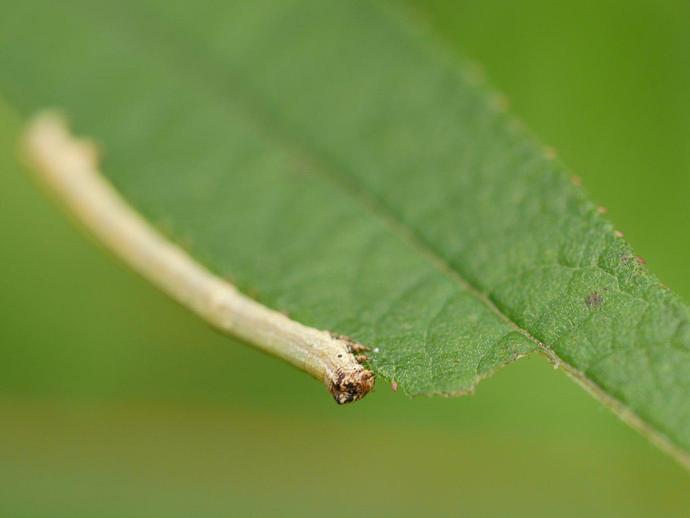September 25, 2020
Inchworms, like the one seen here with a leaf it's been munching on, are caterpillars belonging to the family Geometridae. The name "Geometridae" comes from Ancient Greek and means "to measure the Earth." This name is derived from the unique way that inchworms move around, almost as though they're taking careful measurements. Unlike many caterpillars, inchworms don't have legs running the entire length of their body; instead, they have several pairs of legs at the front of their body and two or three pairs at their posterior end. To move around, they clasp with their front legs, draw their hind end forward, and then clasp with their hind legs and push the front part of their body forward. When they draw their hind legs up, their body forms a little loop, which gives these caterpillars the common nickname "loopers" (although the cabbage looper and soybean looper caterpillars are not members of the family Geometridae).
Geometridae is a huge family of moths with about 23,000 species worldwide and more than 1,400 just in North America! Given the enormous number of species, there's a whole lot of variety when it comes to the adult moths. Some are quite striking, while others are more nondescript. The inchworm caterpillars are pretty much all nondescript, with most being a drab green, gray, or brown color. However, this gives them a great advantage when it comes to camouflage; when threatened, many species will latch onto a twig with their rear legs and "stand" straight up. Nearby predators will think they're just a twig and pass them by! #BenInNature
ABOUT #BENINNATURE
Social distancing can be difficult, but it presents a great opportunity to become reacquainted with nature. In this series of posts, Administrator of Science Ben Williams ventures outdoors to record a snapshot of the unique sights that can be found in the natural world. New updates are posted Monday - Friday, with previous posts highlighted on the weekends.
NATURE PHOTO IDENTIFICATIONS
If you discover something in nature that you would like help identifying, be sure to message us right here on Facebook with a picture (please include location and date of picture) and we'll have our experts help you identify it!

 Hours & Admissions
Hours & Admissions Directions
Directions

